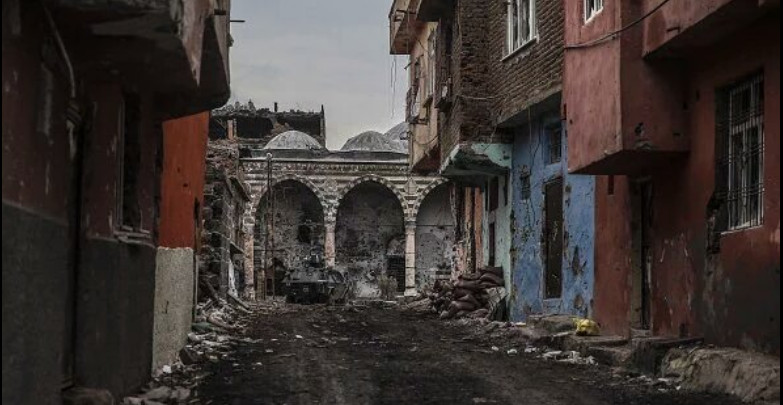

Gentrification and ethnic cleansing use the same techniques, the same machines; they differ in extent, in intensity, but their strategies and aims are similar. We see it in Turkey: while in Istanbul the government bulldozed the gecekondu and other popular neighborhoods, to open new spaces for commerce and the affluent, in the occupied region of Kurdistan it displaces the traditional residents by promoting tourism and beautification of the historical cities.In the capital city of Amed, which the Turkish government calls Diyarbakir, the historical district of Sur is suffering an ’urbicide’, with over 30.000 displaced and 70% of the buildings destroyed.
On the other side of the Tigris (whose Kurdish name is Dicle) the residents of Fiskaya neighborhood still leave their doors open: they know each other, and live collectivism as a natural fact. But the streets are steep, narrow, and hard to reach for the police; moreover, its people are mostly voters of the pro-Kurdish HDP party, and symphatisers of Abdullah Ocalan’s banned PKK. Thus, the neighborhood represents a problem for the Turkish government, that addresses it as in Istanbul’s Sulukulé and Tarlabase: by offering to the residents apartments in the newly built TOKI public housing uphill. Many residents accept them to escape the discomfort of living in their old houses; but others see the project as an attack to the culture of their community, through the destruction of the neighborhood, urban renewal and ‘regeneration’, together with the anonymity in which residents will be secluded after relocation in the new apartments.

- Defne Kadioğlu Polat, “Sur: Urban renewal in the Southeast Anatolian war zone“, Open Democracy, 21/1/2016.
- Mireille Sen, “Urbicidio a Sur, Diyarbakir“, Eddyburg, 21/7/2016, testo completo in PDF (italiano).
- Declarations of Amed Chamber of Architects on ANF News: “AKP wants to isolate Sur and force people to accept TOKI“, 30/3/2016 :: “Sur and its memory is being destroyed“, 19/5/2016.
- Jérémie Berlieux, “Aprés les combats, la gentrification“, Le Courier, 14/5/2016.
- Adriano Sofri, “Diyarbakir, dove tutto è cominciato“, La Repubblica, 19/10/2015.
- David Lepeska, “The destruction of Sur: is this historic district a target for gentrification?“, The Guardian, 9/2/2016.
- More on Istanbul and the strategy of TOKI: D. Lepeska “Istanbul’s furious bid to become the new Dubai“, NextCity, 2013 :: D. Lepeska “Istanbul gentrification by force leave locals feeling overwhelmed and angry“, The Guardian, 2014 :: N. Glastonbury, D. Kadioğlu “Cleaning out the ghettos: Urban governance and the remaking of Kurdistan“, Jadaliyya, 18/3/2016.
- Photos of Sur by the independent photoreporter Mahmut Bozarslan.
- The resistance against the hydroelectric plant of Hasankeyf: Joris Leverink, “Flooding History“, sobre el pantano de Ilisu :: blog Hasankeyf Matters. See also this report on forced displacement in south-eastern Turkey.
- Three older posts on Turkey in Perifèries Urbanes: Taksim es del pueblo! (2013) :: Sulukulé, el primer barrio gitano de Europa (2011) :: Istanbul vivir en la exclusión voluntaria e involuntaria (2010)